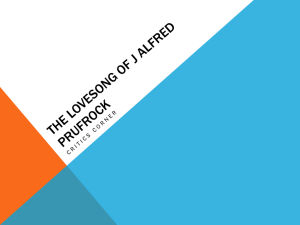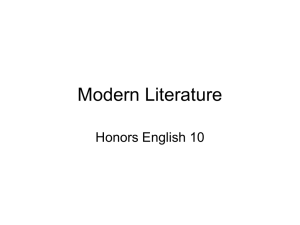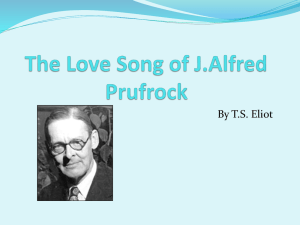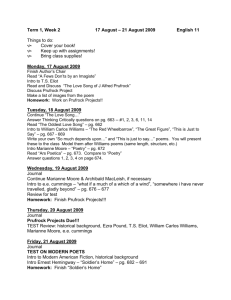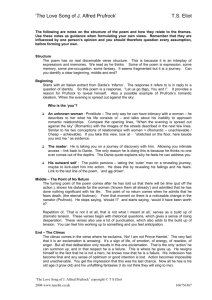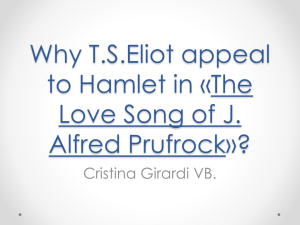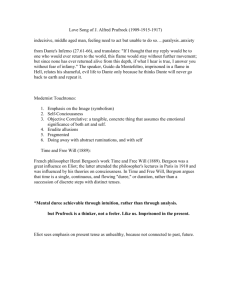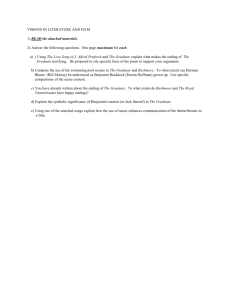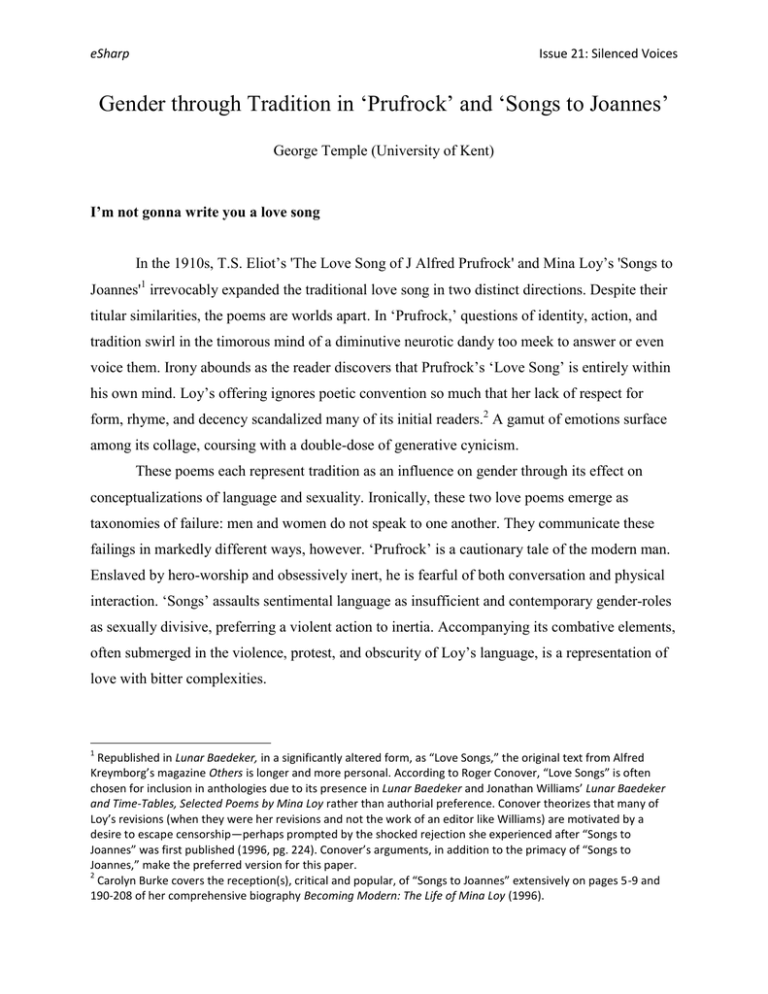
eSharp
Issue 21: Silenced Voices
Gender through Tradition in „Prufrock‟ and „Songs to Joannes‟
George Temple (University of Kent)
I’m not gonna write you a love song
In the 1910s, T.S. Eliot‟s 'The Love Song of J Alfred Prufrock' and Mina Loy‟s 'Songs to
Joannes'1 irrevocably expanded the traditional love song in two distinct directions. Despite their
titular similarities, the poems are worlds apart. In „Prufrock,‟ questions of identity, action, and
tradition swirl in the timorous mind of a diminutive neurotic dandy too meek to answer or even
voice them. Irony abounds as the reader discovers that Prufrock‟s „Love Song‟ is entirely within
his own mind. Loy‟s offering ignores poetic convention so much that her lack of respect for
form, rhyme, and decency scandalized many of its initial readers.2 A gamut of emotions surface
among its collage, coursing with a double-dose of generative cynicism.
These poems each represent tradition as an influence on gender through its effect on
conceptualizations of language and sexuality. Ironically, these two love poems emerge as
taxonomies of failure: men and women do not speak to one another. They communicate these
failings in markedly different ways, however. „Prufrock‟ is a cautionary tale of the modern man.
Enslaved by hero-worship and obsessively inert, he is fearful of both conversation and physical
interaction. „Songs‟ assaults sentimental language as insufficient and contemporary gender-roles
as sexually divisive, preferring a violent action to inertia. Accompanying its combative elements,
often submerged in the violence, protest, and obscurity of Loy‟s language, is a representation of
love with bitter complexities.
1
Republished in Lunar Baedeker, in a significantly altered form, as “Love Songs,” the original text from Alfred
Kreymborg’s magazine Others is longer and more personal. According to Roger Conover, “Love Songs” is often
chosen for inclusion in anthologies due to its presence in Lunar Baedeker and Jonathan Williams’ Lunar Baedeker
and Time-Tables, Selected Poems by Mina Loy rather than authorial preference. Conover theorizes that many of
Loy’s revisions (when they were her revisions and not the work of an editor like Williams) are motivated by a
desire to escape censorship—perhaps prompted by the shocked rejection she experienced after “Songs to
Joannes” was first published (1996, pg. 224). Conover’s arguments, in addition to the primacy of “Songs to
Joannes,” make the preferred version for this paper.
2
Carolyn Burke covers the reception(s), critical and popular, of “Songs to Joannes” extensively on pages 5-9 and
190-208 of her comprehensive biography Becoming Modern: The Life of Mina Loy (1996).
eSharp
Issue 21: Silenced Voices
There are significant differences between the two works that must be considered before
any extended comparative study. „Prufrock‟ is, generally speaking, more playful than „Songs to
Joannes,‟ and frequently presents pun and absurdity via the mock-heroics of its main voice.
Additionally, its sing-songy rhymes lend it a light-hearted tone despite the images portrayed in
the poem, which include anesthesia, seedy city streets, and dismembered women (2; 4-9, 70-72;
55, 623). „Prufrock‟ also gives us hints, in lines like „Do I dare to eat a peach?‟ (122), that we are
not expected to take its protagonist seriously. Eliot ironizes Prufrock, being sure not to prescribe
his attitudes, while Loy‟s voice in „Songs to Joannes‟ is her own reflective consideration and its
humor is never at the expense of the credibility of her voice. „Prufrock‟ whispers its questions of
gender tangentially, while „Songs‟‟ whispers are measured scorn. Loy‟s mythic vignettes are not
allowed to dominate the poem, whether „Pig Cupid‟ (3) or the parable of the virgins (14-16).
„Songs‟ is personal4, while „Prufrock‟ is epic; an observation which would likely please Eliot as
well as Loy.
Eliot’s Tradition
The differences in text are complemented by the drastic differences in their respective
authors. Eliot‟s work (both as creative author and critic) provides a trove of published material
concerning his theories and practice. This is hardly the case for Loy, who published three critical
essays during her lifetime, one of which was only recently discovered (Conover, 1996, p.217).
„Tradition and the Individual Talent‟ provides particularly illuminating insight into „Prufrock‟
when Eliot says, of the poet, that „the most individual parts of his work may be those in which
the dead poets, his ancestors, assert their immortality most vigorously5„ (1956, p.48). Contrasting
with Eliot‟s traditional theory are Loy‟s „Aphorisms on Futurism,‟ where she uses „that rubbish
heap of race-tradition‟ (1996, p.152) as a term of derision for the human subconscious. As
Virginia Kouidis observes, „Futurism seems to have awakened Mina Loy to . . . the need to reject
the strictures of the past‟ (1997, n.p.). Eliot‟s idea that „the poet must develop or procure the
3
Quotations from 'Prufrock’ are from the 1974 Faber edition of Eliot's Collected Poems, and both they and the
citations from ‘Joannes’ reference line numbers rather than page numbers.
4
Peter Ackroyd’s biography of Eliot quotes several of his Harvard course-mates who describe him as a “dandy,”
“well dressed,” and “bookish” (30), suggesting a more intimate relationship between poet and Prufrock than is
often assumed.
5
This interpretive clue enables an Eliot critic to make otherwise risky interpretive leaps in the cases where Eliot
alludes, as I will do in this paper.
eSharp
Issue 21: Silenced Voices
consciousness of the past‟ (1956, p.52) disagrees with Loy, who terms the past „a trail of
insidious reactions‟ and bans reliance on „the turbid stream of accepted facts‟ (1996, p.150). The
two viewpoints are not directly opposed, as Eliot insists that „novelty is better than repetition‟
(1956, p.49), and Loy‟s poetry does allude to previous writers, their starting points and attitudes
are radically different.
Prufrock‟s place in the Western literary tradition of Dante, Shakespeare, and the Bible
consistently paralyzes him with feelings of inadequacy. The patriarchal literary history of which
he is a part is shaped by individuals who accomplish heroic deeds, in diametric opposition to his
life, measured in coffee spoons. This perceived unimportance couples with his sense of propriety
to inflate his self-consciousness and inhibit him from expressing himself out of fear. Prufrock‟s
exclamation „No! I am not Prince Hamlet, nor was meant to be‟ (111) introduces Shakespeare's
anti-hero into the cadence of the Inferno‟s „For I am not Aeneas, am not Paul; / nor I nor others
think myself so worthy‟ (Alighieri, 1995, lines 32-33, Canto 2). In this section, Dante is
protesting to Virgil that he is unfit to overcome the trials that prevent his ascent to heaven.
Prufrock‟s denial, like Dante‟s, is an instance of perceived inadequacy in relation to a character
of literary fame. This character of negation is exemplified by his refusal to identify with John the
Baptist, insisting „I am no prophet—and here‟s no great matter‟ (83). As the poem nears its end,
the irony inflates:
I grow old . . . I grow old . . .
I shall wear the bottoms of my trousers rolled.
Shall I part my hair behind? Do I dare to eat a peach?
I shall wear white flannel trousers and walk upon the beach.
(120-23)
In the Inferno, Dante proceeds, overcoming his self-esteem issues with the help of Virgil.
Prufrock, in contrast, remains inert and stagnantly aging to ponder fashion and diet.
Dante and Prufrock are both surrounded by their „ancestors‟ in their writings. Unlike
Dante, however, Prufrock never sets out on a journey—he only plans, and realizes the futility of
his plans—the streets he travels „follow like a tedious argument‟ (8) and he fears that even his
hypothetical vacation, a „walk upon the beach,‟ will be deadly. Dante‟s journey begins in a
wood, lost, and his journey is to find—Prufrock is always within his own mind, and
consequently has no intended destination.
eSharp
Issue 21: Silenced Voices
„Prufrock‟ is contextualized within Eliot‟s Western literary tradition from the outset of
the poem. Allen Mandelbaum translates the epigraph, taken from Canto XXVII of Dante‟s
Inferno, as:
If I thought my reply were meant for one
who ever could return into the world,
this flame would stir no more; and yet, since none—
if what I hear is true—ever returned
alive from this abyss, then without fear
of facing infamy, I answer you.
(lines 61-66)
Martin Scofield prematurely dismisses any connection between Eliot‟s poetics and the
importance of the epigraph to Prufrock: „Dante‟s Speaker (Montefeltro, a corrupt friar) does not
seem to throw any light on Eliot‟s figure . . . for the reader of the poem it seems an example of
how Eliot‟s erudition may sometimes intrude on his material‟ (1988, p.57). What Scofield
overlooks is the formal importance of the selection from Canto XXVII of Inferno. Montefeltro‟s
confession immediately follows the speech that Eliot quotes, though it is left out of the selection.
In effect, „The Love Song of J Alfred Prufrock‟ comes to replace the story of the deeds of
Montefeltro. The connection between Prufrock and Montefeltro is not one of character but of
situation, as they are both suffering hellacious consequences for their inaction: Prufrock for
never asking the „overwhelming question‟ of line ten, Montefeltro for not repenting and
confessing of his fraudulent counsel6.
In addition to setting the scene for Prufrock‟s dramatic monologue, the Dantean context
points to clues to identifying the ever-present pronouns which are essential to understanding
precisely what Prufrock is saying, and to whom. The poem does not begin, as Scofield writes,
„with the invitation of a Love Song‟ (1988, p.47), since the „you‟ of line one is not Prufrock‟s
lover but a guide to Prufrock‟s urban wanderings. Instead of „Prufrock‟ as a confession of a
failed attempt to express his affection, it becomes a confession of his failure to even try. Without
correctly identifying the poem‟s pronouns, the assertion that Prufrock does not ask his
„overwhelming question‟ could be contended, based in part on lines like „some talk of you and
me‟ (89). If Prufrock is addressing his would-be lover in these lines, then his affliction would be
6
In Montefeltro’s defense, he was pre-emptively absolved by Pope Boniface VIII. The demon of Canto XXVII
reminds us, however, 'one can’t absolve a man who’s not repented, / and no one can repent and will at once; / the
law of contradiction won’t allow it' (lines 118-20). Unfortunately for Montefeltro, logic was not Boniface’s strong
suit.
eSharp
Issue 21: Silenced Voices
the problem of the Biblical Moses, who cannot make himself understood7. Instead, his fear of
miscommunicating keeps him from communicating in the context of his love song. The irony
continues to another level, as the reader is aware of Prufrock‟s difficulty only through his own
musings: the man who can‟t communicate is the voice of a confessional love-song.
Revisiting Prufrock‟s exclamation, he provides further insight into the source of his fear
with:
No! I am not Prince Hamlet, nor was meant to be.
Am an attendant lord, one that will do
to swell a progress, start a scene or two,
advise the prince, no doubt, an easy tool
Deferential, glad to be of use,
Politic, cautious, and meticulous;
Full of high sentence, but a bit obtuse;
At times, indeed, almost ridiculous—
Almost, at times, the Fool.
(111-19)
Prufrock has constantly wavered to this point in his love song, and the comparison to Hamlet‟s
indecisive musings are warranted. The Dane is empowered by the heroic narrative, however, and
eventually decides to act. Prufrock is not the tragic hero, but a minor character: an „attendant
lord,‟ Polonius8. Prufrock denies his kinship with Hamlet as he refuses to act, substituting for
action the questions of propriety with which Polonius is concerned throughout Shakespeare‟s
Hamlet. Prufrock‟s inability to express himself to women follows as a direct consequence of his
consistent identity-relation to the masculine symbols of his literary history, prescribing a set of
tropes he constantly compares himself to.
Loy's Futurism
The literary characters of Prufrock‟s past interdict his present, but the voice of „Songs‟
reacts violently to these intrusions of tradition on her life. For Loy, the traditions of the past have
prescribed gender-imbalanced attitudes, especially toward sex. ‟Pig Cupid his rosy snout /
7
This would consequently be a vital turning point in the poem, forming the climactic point of Prufrock’s
conversation, leading to a completely different reading of the second half of the love song as a reaction to his
lover’s rejection.
8
Polonius, in Shakespeare’s Hamlet, worries that he will be thought a fool (I.iii.114), while Hamlet calls him a fool
three times (III.i.124; then again after killing him in III.iv.36 and 233). Eliot’s language draws our attention to
Polonius’ kinship with Prufrock—his constant self-consciousness and worry of others’ opinions.
eSharp
Issue 21: Silenced Voices
Rooting erotic garbage‟ (3-4) twists the cherubic male love-god into a smut-nosed animal, while
the female self-prescribes:
I must live in my lantern
Trimming subliminal flicker
Virginal to the bellows
Of Experience
(14-17)
Loy‟s allusion to the Parable of the Ten Virgins from Matthew 25 juxtaposes the societal
expectations for the genders: her lover is encouraged by his culture to „root‟ for sexual pleasure.
This is not too distant from Cupid‟s tendency to fire arrows at unsuspecting victims to indulge
his voyeurism. Meanwhile, 'she' is required to wait patiently for the return of the groom to his
wedding feast. In the Biblical parable, the groom‟s arrival is delayed and five „foolish‟ virgins go
out to purchase more oil as theirs is running out. While they are visiting the local merchants, the
groom returns, the door to the feast is shut, and upon the virgins' return they are denied entry.
The hypocrisy of the parable is integral to Loy‟s allusion. Despite the fact that the groom‟s delay
is the only reason that the five „foolish‟ virgins need oil, they are still excluded from the feast.
The groom can be delayed without consequence because the schedule of the evening‟s activities
revolves around him, just as Pig Cupid can root for „erotic garbage.‟ The virgins, however, are
expected to be at the groom‟s beck and call. They must be prepared, in spite of any eventuality,
to celebrate his wedding at the moment of his arrival.
Just as Loy points out the dissonance in traditional gender-roles, she ruthlessly ironizes
sentimental language via juxtaposition:
When we lifted
Our eye-lids on Love
A cosmos
Of coloured voices
And laughing honey
And spermatozoa
At the core of Nothing
(90-95)
This is what Paul Peppis highlights when he observes that „in “Love Songs,” vocabularies of
science and rationality cohabit antagonistically with vocabularies of love and sentiment‟ (2002,
p.574). The extreme abstraction of the language is inappropriate, to Loy, and one of her
responses is to invoke precise scientific language as an attempt to recover genuine expression in
eSharp
Issue 21: Silenced Voices
love poetry. She invokes psychological terminology to ironize the exclusivity of her relationship
to Joannes:
Is it true
That I have set you apart
Inviolate in an utter crystallization
Of all the jolting of the crowd
Taught me willingly to live to share
Or are you
Only the other half
Of an ego‟s necessity (115-22)
The pun on marriage („the other half‟) is combined with the Freudian image, resulting in a
narcissistic desire to possess. Loy again juxtaposes to consider her own motivations, and seems
to reduce her affection for Joannes to mere psychological tendency, cloaking her unconscious
desires in rationalization. Similarly, she contrasts phrases of emotional attachment with sexual
urge, as in XIV:
To you
I bring the nascent virginity of
—Myself for the moment
No love or the other thing
Only the impact of lighted bodies
Knocking sparks off each other
In chaos
(158-64)
Loy again uses alternating imagery to interrogate her own emotions, though here she also
suggests (if not outright rejecting) a consistent self-identity. The „nascent virginity of / —Myself
for the moment‟ suggests an snapshot of a stable self, but includes the impossibility of that self to
remain stable; the future potential of „nascent virginity‟ is completed by the image of bodies‟
friction causing sparks, which is drained of positive connotation with „No love
or the other
thing.‟ The sentimental idea of self is systematically eradicated from sex, reversing the
expectation that a love song would abstract the sexual embrace. These contradictions outline the
idiosyncratic nature of Loy‟s relationship to Joannes, resisting the Romantic tendency to abstract
and idealize past love and instead using Futurist imagery of the machine.
However, Loy admits the appeal of the sentimental ideal in XVI:
We might have lived together
In the lights of the Arno
eSharp
Issue 21: Silenced Voices
Or gone apple stealing under the sea
Or played
Hide and seek in love and cob-webs
And lullaby on a tin-pan
And talked till there were no more tongues
To talk with
And never have known any better
(173-81)
Their Italian paradise, complete with fruit to tempt them, would provide a permanent home for
the lovers. Once again, Loy counterpoints, this time with „love and cob-webs‟ to build tension.
This tabula rasa is impossible, though, because the two lovers do know better, as the last line
implies. Loy consistently weighs Romantic or traditional conceptualizations of love with
scientific or bitter depictions, invariably dismissing the 19th century‟s indulgences as immature.
Loy evokes childish imagery9 throughout „Songs,‟ but section X‟s „Shuttle-cock and
battle-door / A little pink-love / And feathers are strewn‟ (97-99) gives an unexpected
connotation to the backyard game. The „emphasis on the embattled “door” that the “cock” would
enter‟ (Burke 207) provides a tension-releasing trivialization of sex and light poetic play10. There
is more to the lines than a pithy pun for genitalia, however. In a game of badminton, the
descendant of the game to which Loy alludes, the shuttle-cock is rarely used for more than one
match. The process of smacking it about with a racquet (battledore) detaches the feathers that
smooth its descent—with each „impact of lighted bodies‟ (59) the „cock‟ becomes less physically
capable of another round. The line „Feathers are strewn‟ outlines this wear, and implies Loy‟s
dissatisfaction with Joannes‟ sexual contribution to their relationship.
The flow of „Songs‟ embodies Loy‟s poetic, described in 'Modern Poetry' as 'the
spontaneous tempo of their [the poets‟] response to life'11 (Loy, 1996, p.157-58). Linda Kinnahan
concentrates on the embodiment of this idea, asserting that „Loy speaks of the male‟s libidinal
experience from a woman‟s perspective, describing it as "a clock-work mechanism / Running
down against time / To which I am not paced."‟ Here, her focus upon sexual difference locates
itself in the body‟ (1994, p.56-57); Loy reclaims love poetry by refusing to follow the penile
9
One of the “bird-like abortions” (40) of section IV has a baby in a padded porte-enfant “Tied with sarsanet ribbon
/ To her goose’s wings” (47-48), abjuring Mother Goose rhymes, while the bell-ringing pranks of the boy in section
V are decidedly youthful.
10
This is another example of Loy shocking her readers.
11
Which, as her increasingly famous quote claims, “is generally reducible to sex” (qtd. in Burke, 191).
eSharp
Issue 21: Silenced Voices
model for sexual tension and release in the love song, instead providing miniature builds,
climaxes, and interruptions, as in section XIII:
Come to me There is something
I have got to tell you and I can‟t tell
Something taking shape
Something that has a new name
A new dimension
A new use
A new illusion
It is ambient
Something shiny
And it is in your eyes
Something only for you
Something that I must not see
It is in my ears
Something very resonant
Something that you must not hear
Something only for me
Let us be very jealous
Very suspicious
Very conservative
Very cruel
Or we might make an end of the jostling of aspirations
Disorb inviolate egos
Where two or three are welded together
They shall become god
———————
Oh that‟s right
Keep away from me Please give me a push
Don‟t let me understand you Don‟t realize me
Or we might tumble together
Depersonalized
Identical
Into the terrific Nirvana
Me you — you — me
(126-55)
The invitation of a love song begins the stanza, and the contradictions („ambient‟ / „shiny,‟ „only
for you‟ / „only for me‟) continue Loy‟s idiosyncratic depiction of love. The mocking tone of
„Let us be very jealous / Very suspicious / Very conservative / Very cruel‟ would prevent what
she seems to want—to „Disorb inviolate egos.‟ Perhaps Joannes suggested this course of action
eSharp
Issue 21: Silenced Voices
during their relationship? Or is Loy applying her personal insistence, in „Feminist Manifesto12,‟
that „Women must destroy in themselves, the desire to be loved‟ (1996, p.155)? Rachel Blau
DuPlessis points out the „contradictory relation‟ between the poem and manifesto (1998, p.53),
buy Loy‟s aspiration seems to be an escape from the self in love: the stanza ends with „terrific
Nirvana‟. However, Joannes‟ insistence on distance delays that eventual „seismic orgasm‟ after
Loy‟s miniature tension-point, „They shall become god,‟ breaks its flow with her trademarked
dash-barriers. The poem‟s climax is again delayed by Joannes‟ individuality, made explicit in
XXXI:
Crucifixion
Of a busy-body
Longing to interfere so
With the intimacies
Of your insolent isolation
(390-94)
Joannes‟ independence, akin to the attitude Loy prescribes for women in „Feminist Manifesto,‟
leads to her own suffering as he severs their connection. In effect, she has become a martyred
Christ for pursuing access to Joannes‟ solitude.
(meta)Physical Eliot / Physical Loy
‘Language was developed for one endeavor, and that is . . . To woo women!’
-
John Keating, Dead Poets‟ Society
As the 20th century reincarnation of a Romantic poet unironically asserts,
language, and by extension poetry, employs abstraction to reach physical results. Prufrock‟s love
song is dominated by „a structure of anticipation and memory‟ (Ayers, 2004, p.23), which
echoing the plans and promises of love poetry from English tradition. „Prufrock‟ dialogues
extensively with 'To His Coy Mistress', in many ways the archetypal metaphysical love song.
Marvell begins his lyric of seduction with „Had we but World enough, and Time, / This coyness
Lady were no crime,‟ (1-2) immediately pressuring his lover to renounce her reticence—a song
that could easily be sung to Prufrock, who occasionally mentions that „there will be time‟ (23,
26, 28, 29, 31, 32, 37, 39, 47) as a method of delaying the „crisis‟ of the moment. After
12
Written in 1914, the “Feminist Manifesto” was still unpublished when “Songs to Joannes” was completed, only
finding publication in The Last Lunar Baedeker (Conover 216).
eSharp
Issue 21: Silenced Voices
Prufrock‟s fearfully flickering greatness, he gives cause for hope that he will eventually voice his
question with another allusion to Marvell, asking:
Would it have been worth while
To have bitten off the matter with a smile,
To have squeezed the universe into a ball
To roll it toward some overwhelming question,
(90-93)
Of course, Prufrock does not voice his question. In Marvell‟s poem, the lover encourages „Let us
roll all our Strength, and all / Our sweetness, up into one Ball‟ which Prufrock recoils from.
Instead of the ball as an image of a tightly wound sexual union, Prufrock has created a plaything
to bat in the general direction of his elusive question. His fear of the sexual embrace and
insistence on propriety casts him alongside the critics who called the first four sections of
„Songs‟ „hoggerel‟ or „swill poetry‟ upon their initial publication in Others (Burke, 1996, p.6).
In the case of Andrew Marvell, the abstractions of the love lyric are to the immediate
sexual benefit of the poet. Disconnecting the threat of consequences that encouraged women's
sexual purity from any causal relationship to intercourse is part of Marvell‟s wooing tactic. Loy‟s
„Feminist Manifesto‟ preaches against the „man made bogey of virtue‟ (1996, p.154) prescribing
„the unconditional surgical destruction of virginity through-out the female population at
puberty—‟ (1996 p.155), attacking the same cultural pressure that Marvell‟s love song is trying
to circumvent. While the politics of Marvell‟s seduction are far different from Loy‟s suggested
social programs, his poetry is crafted so that his mistress will forget her „quaint honour‟ (line 29)
and instead „tear our pleasures with rough strife‟ (line 43). This is a similar „emancipation‟ that
Loy envisions in the sexual embrace, though hardly without its problems.13
The patriarchal quality of Prufrock‟s world is summarized by Alicia Ostriker, asking
„Prufrock may yearn to be Hamlet, but what woman would want to be Ophelia?‟ (1982, p.87). In
„Prufrock,‟ Eliot is wholly unconcerned with questions of this sort. Prufrock‟s love song treats
women as objects within his world that exist solely in relation to subjects. The female as subject
appears sparsely within „Prufrock.‟ The refrain, „In the room the women come and go / talking of
Michelangelo‟ (13-14), represents the women of Prufrock‟s world as generalized and transient.
13
There are massive differences in the gender-power dynamics and class pressures of each poem, and I am not
claiming that these two poems exist in an ideal world somehow elevated from history; rather, I wish to point out
that, in spite of these differences, both poets see sexuality as a desired end to which impediments should be
dismissed or destroyed, often without considering wider social consequences.
eSharp
Issue 21: Silenced Voices
There are no specific voices to provide insight or analysis of Michelangelo‟s works, there are
only some women, easily replaced by any other women who engage in the same activity, flitting
in and out of rooms. They remain a nameless and faceless group throughout „Prufrock,‟ and their
„coming and going‟ confirms their transitory status. Prufrock does not give the women names,
juxtaposing the conversationalists with their topic, and using the force of the couplet to showcase
„Michelangelo‟ and subordinate „the women.‟
The conversation that the women have is definitively not of Prufrock. This sentiment is
echoed near the close of his song, by the sirens:
Shall I part my hair behind? Do I dare to eat a peach?
I will wear white flannel trousers and walk upon the beach
I have heard the mermaids singing, each to each.
I do not think that they will sing to me.
(122-25)
Why to each other instead of Prufrock? In The Odyssey, the sirens sing to Odysseus to prevent
him from reaching home, attempting to lure him to a slow death from their rapturous song. Since
Prufrock is not the hero Odysseus, the great man whose greatness deserves female attention, he
does not think that they will sing to him. Contrast this with Loy‟s praise and deprecation for
Joannes in XV of „Songs‟:
Seldom Trying for Love
Fantasy dealt them out as gods
Two or three men looked only human
But you alone
Superhuman apparently
I had to be caught in the weak eddy
Of your drivelling humanity
To love you most
(165-172)
Loy‟s initial attraction is to Joannes‟ excellence—he is better than the other men. The „Fantasies‟
of the first line revisit her ideas, this time to spawn a preference for a lover. She asserts, however,
that her love for Joannes came from „the weak eddy‟ of his „drivelling humanity.‟ This is yet
another example of the complex treatment Loy gives to her own emotions—illustrating them
with object-images that are impossible to simplify without divesting them of what Charles Olson
would later call „proper confusions‟ (391).
eSharp
Issue 21: Silenced Voices
Confusion likewise appears whenever Prufrock imagines a female voice. Insisting „That
is not what I meant at all‟ (97, 110), the woman‟s voice is cacophonic to his love song. Because
Prufrock might „presume,‟ precisely as he did not want to do (54, 68), she might shame him.
Reiterating their trifling nature, Prufrock imagines them obsessed with his physical appearance,
cattily gossiping „How his hair is growing thin!‟ (41) and „But how his arms and legs are
thin!‟(44) while he wonders „Do I dare / disturb the universe?‟ (45-46). These voices are
controlled, introduced, and ushered out of earshot by Prufrock. In this way, Prufrock‟s imagined
voices become self-fulfilling prophecies of his own failure. Even his companion, the „you‟ of
line one, is silenced with „Oh, do not ask, „What is it?‟‟ (12). The last line of the poem underlines
his difficulty, when he finally experiences another ego and „human voices wake us, and we
drown‟ (131). Again, remembering that this is a love song provides a comic tint to this
depressing finish: how could Prufrock have ever hoped to sing it in the first place? Singularity of
perspective forms Prufrock‟s fragmented reality, reducing all „others‟ to objects within his sight.
Just as I have argued that the introduction of female voices confuses Prufrock, Tony
Pinkney asserts that „It is proximity to the female body that ruptures narrative continuity‟ (1984,
p.40). The female body is introduced, as most of the images in „Prufrock,‟ as a series of what
Pinkney calls „part-objects‟ (1984, p.40):
And I have known the eyes already, known them all—
The eyes that fix you in a formulated phrase
. . . . . . . . . . . . . . . . . . . . . . .
And I have known the arms already, known them all—
Arms that are braceleted and white and bare
(But in the lamplight, downed with light brown hair!)
. . . . . . . . . . . . . . . . . . . . . . .
Arms that lie along a table, or wrap about a shawl.
(50-51; 62-64; 67)
Prufrock‟s inability to communicate with women has resulted in their dismemberment and
fetishization. As Jan Montefiore quips, „the women may be in pieces, but they are terribly sexy‟
(2011, n.p). His paralysis, caused by the eyes‟ „formulated phrase,‟ is a direct reaction to his
inability to interact with an ego other than his own. He insists that „I should have been a pair of
eSharp
Issue 21: Silenced Voices
ragged claws / Scuttling across the floors of silent seas14‟ (73-74), because his proper
representation is a part-object in relation to other part-objects.
Eliot‟s treatment of a potential lover in „Prufrock‟ is mirrored by Loy‟s reflections on her
former lover in „Songs.‟ That both of these poems dismember their lovers is significant. Instead
of metaphors for the lovers‟ identities, each speaker concentrates on a part of the body and its
effect on them. Loy uses her lover‟s genitals as metonym, while Eliot allows his polite masculine
gaze to drift to socially acceptable points of focus. Joannes is a „skin-sack,‟ (17) both a scrotal
image and a surreal reduction of her lover to nothing more than a physical form. This limiting is
reinforced with „something the shape of a man‟ (21), providing a cynical objectification of
Joannes which surfaces repeatedly in the poem. As with Prufrock, Loy‟s trouble interacting with
her lover results in a reductive and separating approach. Unlike Prufrock, Loy has the past
success of „ephemeral conjunction‟ (303) to contrast with the present „Withdrawal of your sun‟
(323), providing „Songs‟ with a much broader account of their interaction, from their „humid
carnage‟ (111) to „cool cleaving‟ (203).
Conclusion
Loy‟s „Spawn of Fantasies‟ is commentary on culture and language as well as the
relationships that are a/effected by them. She romps through a disintegrated relationship to
criticize the influence of the past, and leaves an idiosyncratic record of love in a time of intense
personal and political flux. „Prufrock,‟ addressing issues of identity and language through Eliot‟s
traditional15 lens, highlights the problem of self-consciousness in the reflective literary man
while mocking it all the while. These two love songs, imbued with the troubles of their authors‟
experiences, provide complicating ideas of gender-relations in the originary stages of
„Modernism.‟ The issues they raise contribute to an understanding of love in the early 20th
century which is nuanced as well as stark, committing prejudices and predilections alike to their
literary descendants. Their discussion is evidence that Loy was right: ‟Love,‟ is, as she wrote in
„Songs to Joannes‟‟ last line, „the preeminent litterateur.‟
14
Tony Pinkney elucidates an image originally posited by Michael Edwards in Eliot/Language—the crab as writer’s
hand, belying Prufrock’s fragile grasp on language. For more on this, see pages 40-41 of Women in the Poetry of
T.S. Eliot.
15
In his sense of the word: “in consideration of the past.”
eSharp
Issue 21: Silenced Voices
Bibliography
Ackroyd, Peter. 1984. T.S. Eliot. London: Hamish-Hamilton.
Alighieri, Dante. 1995 Inferno. The Divine Comedy. Allen Mendelbaum (translator). New York:
Alfred A. Knopf. 57-213.
Ayers, David. 2004. Modernism: A Short Introduction. Oxford: Blackwell Publishing.
Burke, Carolyn. 1996. Becoming Modern: the Life of Mina Loy. New York: Farrar, Straus, and
Giroux.
Conover, Roger L., ed. 1996 The Lost Lunar Baedeker. London: Carcanet Press Limited.
DuPlessis, Rachel Blau. 1998. Seismic Orgasm. In Maria Shreiber & Keith Tuma (ed.). Mina
Loy: Woman and Poet. Orono, ME: National Poetry Foundation. 45-74.
Eliot, Thomas Stearns. 1918. Observations. In The Egoist. 5.5, 69-70. Brown University Center
for Digital Initiatives. Web. (20 Jan 2012)
Eliot, Thomas Stearns. 1953. Tradition and the Individual Talent. In The Sacred Wood. 7th Ed.
London: Methuen and Company. Print.
Eliot, Thomas Stearns. 1974. The Love Song of J Alfred Prufrock. In Collected Poems 19091962. London: Faber and Faber. 13-17. Print.
Kinnahan, Linda A. Poetics of the Feminine. New York: Cambridge University Press, 1994.
Print.
Kouidis, Virginia M. Rediscovering Our Sources: The Poetry of Mina Loy. In Boundary 2. 8.3
(1980). 167-188. Reprinted in Poetry Criticism. 16 (n.p.). Margaret Haerens & Christine
Slovey, eds. Detroit: Gale Research, 1997. Literature Resource Center. Web.
(20 Dec. 2011)
Loy, Mina. 1914. Aphorisms on Futurism. In Conover 1996. 149-53.
eSharp
Issue 21: Silenced Voices
Loy, Mina. 1914. Feminist Manifesto. In Conover 1996. 153-56.
Loy, Mina. 1925. Modern Poetry. In Conover 1996. 157-61.
Loy, Mina. 1917. Songs to Joannes. In Conover 1996. 53-68.
Marvell, Andrew. 1681. To his Coy Mistress. In Miscellaneous poems. London: Robert Boulter.
19-20. Literature Online. Web. (18 Dec 2011)
Montefiore, Jan. Personal Interview. Nov 2011.
Olson, Charles. 1960. Projective Verse. In The New American Poetry 1945-1960. Editor Donal
Allen. Berkeley, CA: University of California Press, 1960. 387-97. Print.
Ostriker, Alicia. 1982. The Thieves of Language: Women Poets and Revisionist Mythmaking. In
Signs. 8.1. 68-90. JStor. Web. (27 Nov 2011)
Peppis, Paul. 2002. Rewriting sex: Mina Loy, Maria Stopes, and Sexology. In
Modernism/Modernity 9.4. 561-79. Project MUSE. Web. (17 Dec 2011)
Pinkney, Tony. 1984. Women in the Poetry of T.S. Eliot. London: MacMillan Press. Print.
Scofield, Martin. 1988. T.S. Eliot: the Poems. Cambridge: Cambridge University Press. Print.
Shakespeare, William. 1909-14. In The Tragedy of Hamlet, Prince of Denmark. The Harvard
Classics. Ed. Charles W. Eliot. Vol. 46, Part 2. New York: P.F. Collier & Son.
Bartelby.com. Web. (15 January 2012) .
Williams, Robin, performer. 1989. Dead Poets Society. Touchstone Pictures. Film.

